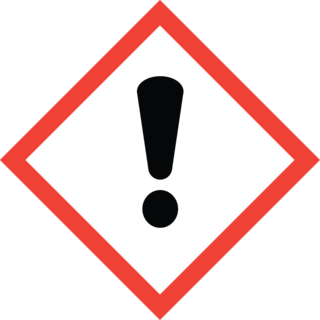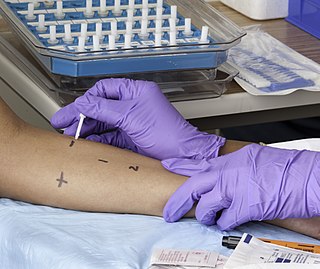Delusional parasitosis (DP) is a mental disorder in which individuals have a persistent belief that they are infested with living or nonliving pathogens such as parasites, insects, or bugs, when no such infestation is present. They usually report tactile hallucinations known as formication, a sensation resembling insects crawling on or under the skin. Morgellons is considered to be a subtype of this condition, in which individuals have sores that they believe contain harmful fibers.

Cypermethrin (CP) is a synthetic pyrethroid used as an insecticide in large-scale commercial agricultural applications as well as in consumer products for domestic purposes. It behaves as a fast-acting neurotoxin in insects. It is easily degraded on soil and plants but can be effective for weeks when applied to indoor inert surfaces. Exposure to sunlight, water and oxygen will accelerate its decomposition. Cypermethrin is highly toxic to fish, bees and aquatic insects, according to the National Pesticides Telecommunications Network (NPTN). It is found in many household ant and cockroach killers, including Raid, Ortho, Combat, ant chalk, and some products of Baygon in Southeast Asia.

Irritation, in biology and physiology, is a state of inflammation or painful reaction to allergy or cell-lining damage. A stimulus or agent which induces the state of irritation is an irritant. Irritants are typically thought of as chemical agents but mechanical, thermal (heat), and radiative stimuli can also be irritants. Irritation also has non-clinical usages referring to bothersome physical or psychological pain or discomfort.
Paresthesia is an abnormal sensation of the skin with no apparent physical cause. Paresthesia may be transient or chronic, and may have many possible underlying causes. Paresthesias are usually painless and can occur anywhere on the body, but most commonly occur in the arms and legs.

Itch is a sensation that causes a strong desire or reflex to scratch. Itches have resisted many attempts to be classified as any one type of sensory experience. Itches have many similarities to pain, and while both are unpleasant sensory experiences, their behavioral response patterns are different. Pain creates a withdrawal reflex, whereas itches leads to a scratch reflex.

Miliaria, commonly known as heat rash, sweat rash, or prickly heat, is a skin disease marked by small, itchy rashes due to sweat trapped under the skin by clogged sweat-gland ducts. Miliaria is a common ailment in hot and humid conditions, such as in the tropics and during the summer. Although it affects people of all ages, it is especially common in children and infants due to their underdeveloped sweat glands.
Burning feet syndrome, also known as Grierson-Gopalan syndrome, is a medical condition that causes severe burning and aching of the feet, hyperesthesia, and vasomotor changes of the feet that lead to excessive sweating. It can even affect the eyes, causing scotoma and amblyopia. The condition occurs more frequently in women, and usually manifests itself when a person is between twenty and forty years old.

Prurigo nodularis (PN), also known as nodular prurigo, is a skin disease characterised by pruritic (itchy) nodules which usually appear on the arms or legs. Patients often present with multiple excoriated lesions caused by scratching. PN is also known as Hyde prurigo nodularis, Picker's nodules, atypical nodular form of neurodermatitis circumscripta, lichen corneus obtusus.

Referred itch or mitempfindung is the phenomenon in which a stimulus applied in one region of the body is felt as an itch or irritation in a different part of the body. The syndrome is relatively harmless, though it can be irritating, and healthy individuals can express symptoms. Stimuli range from a firm pressure applied to the skin – a scratch – to irritation or pulling on a hair follicle on the skin. The referred sensation itself should not be painful; it is more of an irritating prickle leading to the compulsion to scratch the area. The stimulus and referred itch are ipsilateral. Also, because scratching or putting pressure on the referred itch does not cause the stimulus area to itch, the relationship between the stimulus and the referred itch is unidirectional. The itching sensation is spontaneous and can cease with continued stimulation.
Dysesthesia is an unpleasant, abnormal sense of touch. Its etymology comes from the Greek word "dys," meaning "bad," and "aesthesis," which means "sensation". It often presents as pain but may also present as an inappropriate, but not discomforting, sensation. It is caused by lesions of the nervous system, peripheral or central, and it involves sensations, whether spontaneous or evoked, such as burning, wetness, itching, electric shock, and pins and needles. Dysesthesia can include sensations in any bodily tissue, including most often the mouth, scalp, skin, or legs.
Pruritus ani is the irritation of the skin at the exit of the rectum, known as the anus, causing the desire to scratch. The intensity of anal itching increases from moisture, pressure, and rubbing caused by clothing and sitting. At worst, anal itching causes intolerable discomfort that often is accompanied by burning and soreness. It is estimated that up to 5% of the population of the United States experiences this type of discomfort daily.

Dermatitis herpetiformis (DH) is a chronic autoimmune blistering skin condition, characterised by intensely itchy blisters filled with a watery fluid. DH is a cutaneous manifestation of coeliac disease, although the exact causal mechanism is not known. DH is neither related to nor caused by herpes virus; the name means that it is a skin inflammation having an appearance similar to herpes.

Notalgia paresthetica or Notalgia paraesthetica (NP) (also known as "Hereditary localized pruritus", "Posterior pigmented pruritic patch", and "subscapular pruritus") is a chronic sensory neuropathy. Notalgia paresthetica is a common localized itch, affecting mainly the area between the shoulder blades (especially the T2–T6 dermatomes) but occasionally with a more widespread distribution, involving the shoulders, back, and upper chest. The characteristic symptom is pruritus (itch or sensation that makes a person want to scratch) on the back, usually on the left hand side below the shoulder blade (mid to upper back). It is occasionally accompanied by pain, paresthesia (pins and needles), or hyperesthesia (unusual or pathologically increased sensitivity of the skin to sensory stimuli, such as pain, heat, cold, or touch), which results in a well circumscribed hyperpigmentation of a skin patch in the affected area.
Brachioradial pruritus is an intense itching sensation of the arm usually between the wrist and elbow of either or both arms. The itch can be so intense that affected individuals will scratch their own skin to a bleeding condition.
Prurigo simplex is a chronic, itchy, idiopathic skin condition characterized by extremely itchy skin nodules and lesions. Typically, there is no known direct cause of prurigo simplex, but some factors are known to trigger or aggravate it. This condition falls between chronic and acute, sometimes transitioning into a chronic condition. Many people experience a recurrence of the condition after periods of remission. Middle-aged patients are the most prone age group to this condition.

Trombiculidae, commonly referred to in North America as chiggers and in Britain as harvest mites, but also known as berry bugs, bush-mites, red bugs or scrub-itch mites, are a family of mites. Chiggers are often confused with jiggers – a type of flea. Several species of Trombiculidae in their larva stage bite their animal or human host and by embedding their mouthparts into the skin cause "intense irritation" or "a wheal, usually with severe itching and dermatitis".
Morgellons is the informal name of a self-diagnosed, scientifically unsubstantiated skin condition in which individuals have sores that they believe contain fibrous material. Morgellons is not well understood, but the general medical consensus is that it is a form of delusional parasitosis, on the psychiatric spectrum. The sores are typically the result of compulsive scratching, and the fibers, when analysed, are consistently found to have originated from cotton and other textiles.
Senile pruritus is one of the most common conditions in the elderly or people over 65 years of age with an emerging itch that may be accompanied with changes in temperature and textural characteristics. In the elderly, xerosis, is the most common cause for an itch due to the degradation of the skin barrier over time. However, the cause of senile pruritus is not clearly known. Diagnosis is based on an elimination criteria during a full body examination that can be done by either a dermatologist or non-dermatologist physician.

Tactile hallucination is the false perception of tactile sensory input that creates a hallucinatory sensation of physical contact with an imaginary object. It is caused by the faulty integration of the tactile sensory neural signals generated in the spinal cord and the thalamus and sent to the primary somatosensory cortex (SI) and secondary somatosensory cortex (SII). Tactile hallucinations are recurrent symptoms of neurological diseases such as schizophrenia, Parkinson's disease, Ekbom's syndrome and delirium tremens. Patients who experience phantom limb pains also experience a type of tactile hallucination. Tactile hallucinations are also caused by drugs such as cocaine and alcohol.

Allergies in children, an incidence which has increased over the last fifty years, are overreactions of the immune system often caused by foreign substances or genetics that may present themselves in different ways. There are multiple forms of testing, prevention, management, and treatment available if an allergy is present in a child. In some cases, it is possible for children to outgrow their allergies.











